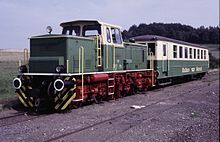Brohltalbahn VT 50
| Brohltalbahn VT 50 | |
|---|---|
|
historical photo
|
|
| Numbering: |
Brohltalbahn VT 50 Brohltalbahn VB 50 |
| Number: | 1 |
| Manufacturer: | DWK Kiel |
| Year of construction (s): | 1926 |
| Retirement: | 1939 |
| Axis formula : | (1A) (A1) |
| Gauge : | 1000 mm ( meter gauge ) |
| Length over coupling: | 18,000 mm |
| Trunnion Distance: | 12,500 mm |
| Bogie axle base: | 1,550 mm |
| Empty mass: | 23,000 kg |
| Service mass: | 30,600 kg |
| Top speed: | 35 km / h |
| Installed capacity: | 150 hp (110 kW) |
| Motor type: | DWK |
| Motor type: | Six-cylinder four-stroke petrol engine |
| Rated speed: | 1,000 / min |
| Power transmission: | mechanically |
| Seats: | 16 2nd class 55 3rd class |
| Classes : | 2nd / 3rd |
The Brohltalbahn VT 50 was a four-axle, narrow-gauge railcar of the Brohltalbahn . It was manufactured by Deutsche Werke Kiel AG in Kiel in 1926 and was intended to streamline the company's operations.
The railcar was converted to a wood gas drive in 1932 and a sidecar in 1939. The car is still there today and is operated by the company as a volcano express .
History and commitment
In order to end the mixed traffic on its network, the Brohltalbahn procured a railcar from DWK in Kiel and named it the VT 50 . With the vehicle, the passenger traffic could be carried out according to species and the travel time on the Brohltalbahn between the end points could be halved.
After the advent of the diesel railcar, the VT 50 was no longer economical and was equipped with a wood gasification boiler. This saved fuel and local raw materials could be used. The costs for the benzene operation amounted to around 30 RM per day of operation, they could be reduced to 5.4 RM with the wood gasifier. By 1934, the railcar had driven 430,000 kilometers since it was put into service. Before the conversion, the consumption of benzene should have been 100 l / 100 km drive. With the arrival of further railcars of the KBE 305 ... 311 series and their conversion to diesel engines, the VT 50 was no longer used. By removing the engine, it was converted into a sidecar in 1939.
The car remained in use until the end of regular passenger train service in 1961. With the 11 nm locomotive he was used in the last passenger train on the Brohl Valley Railway. The car was preserved and was used as a route coach.
After the first special trips with the Vulkan-Express were carried out on the remaining stretch of the Brohltalbahn in 1977, this offer was carried out regularly from 1992 by the Brohltal Schmalspureisenbahn (IBS) interest group . The VN 50 was converted into a saloon car for this purpose.
Constructive features
The railcar belonged to the DWK model series V. In this model series, the entire machine system, including its trough-shaped machine support frame in the center of the bogies, was stored in the track sockets for the first time with DWK railcars . The machine system could be exchanged without lifting the car body. In addition, the machine system was freely accessible and exchangeable by lifting flaps. The car body was made of all-steel construction as a rivet construction and had the typical head shape of DWK cars. It was supported by coil springs on the weighing beams of the bogies. The underframe carries the box frame, which is clad with two millimeter thick sheet metal. All sheet metal connections are riveted. The interior was made of plywood.
The gasoline engine transferred its power to a four-speed gearbox via a foot-operated dry clutch . This was switched mechanically with gear shifts and enabled speeds of up to 35 km / h in the individual gears. The inner wheel sets of each bogie were driven by cardan shafts and axle drives. The wheel sets were stored in roller bearings.
Several lamellar coolers were arranged on the roof for water cooling. The passenger compartment was heated by the engine cooling water. The fuel container was also on the roof. The fuel was fed to the gasifier via protected pipes through the natural gradient.
literature
- Gerd Wolff: 90 years of the Brohl Valley Railway . EK Verlag, Freiburg 1991, ISBN 3-88255-530-0 .
- Dr. Rolf Löttgers: The railcars of the Deutsche Werke Kiel . Uhle & Kleimann, Lübbecke 1988, ISBN 3-922657-61-3 , p. 70-71 .
Web links
- Photo of the VB 50 on the Brohltalbahn 1967 at the Joachim Schmidt Railway Foundation
- Website about the history of the Brohltalbahn with a mention of the VT 50
- Photo of the VB 50 as a saloon car for the Vulkan-Express
Individual evidence
- ↑ a b Internet page about the Brohltalbahn with mention of the VT 50
- ↑ Photo of the VT 50 with wood gasifier
- ↑ Dr. Rolf Löttgers: The railcars of the Deutsche Werke Kiel . Uhle & Kleimann, Lübbecke 1988, ISBN 3-922657-61-3 , p. 70-71 .
- ↑ a b Presentation of the VB 50 as a saloon car
- ↑ Rolf Löttgers: The railcars of Deutsche Werke Kiel. Uhle and Kleimann Verlag, Lübbecke 1988, ISBN 3-922657-61-3 , page 154
- ↑ Rolf Löttgers: The railcars of Deutsche Werke Kiel. Uhle and Kleimann Verlag, Lübbecke 1988, ISBN 3-922657-61-3 , page 51
- ↑ a b Rolf Löttgers: The railcars of Deutsche Werke Kiel. Uhle and Kleimann Verlag, Lübbecke 1988, ISBN 3-922657-61-3 , page 52
- ↑ Heinz Kurz: The railcars of the Reichsbahn types. EK-Verlag, Freiburg 1988, ISBN 3-88255-803-2 , p. 11

